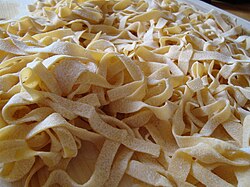Fettuccine[a][b] is a type of pasta popular in Roman cuisine. It is descended from the extremely thin capelli d'angelo of the Renaissance,[2] but is a flat, thick pasta traditionally made of egg and flour (usually one egg for every 100 grams or 3.5 ounces of flour). At about 6.5 mm (1⁄4 inch), it is wider and thicker than, but similar to, the tagliatelle typical of Bologna,[3][4] which are more common elsewhere in Italy and is often used as a synonym. Spinach fettuccine is made from spinach, flour and eggs.
 Fresh, uncooked fettuccine | |
| Alternative names | Fettucce (wider), fettuccelle (narrower) |
|---|---|
| Type | Pasta |
| Place of origin | Italy |
| Main ingredients | Flour, eggs |
The terms fettucce and fettuccelle are often used as synonyms for this pasta, but the former term is more precisely used for wider (about 13 mm or 1⁄2 inch) and the latter for narrower (about 3 mm or 1⁄8 inch) forms of the same pasta.[5]
Fettuccine is often classically eaten with sugo d'umido ('beef ragù') or ragù di pollo ('chicken ragù').[4] A famous dish made with fettuccine is fettuccine Alfredo, a simple dish of pasta, Parmesan cheese and butter which was created and named at a restaurant in Rome in the early 20th century as a tableside "performance".[6] It is popular in the United States, where it is made with cream, although almost unknown in Italy.[7][8][9][10]
Fettuccine is traditionally made fresh (either at home or commercially), but dried fettuccine can also be bought in stores.
See also
editMedia related to Fettuccine at Wikimedia Commons
Notes
edit- ^ /ˌfɛtəˈtʃiːni/ fet-ə-CHEE-nee, UK also /ˌfɛtʊ-/ fet-uu-[1]
- ^ Italian: [fettutˈtʃiːne]; lit. 'little ribbons'; sg. fettuccina
References
edit- ^ "fettuccine". Oxford English Dictionary (Online ed.). Oxford University Press. doi:10.1093/OED/7286818920. Retrieved 19 March 2024. (Subscription or participating institution membership required.)
- ^ Zanini De Vita, Oretta (15 October 2009). Encyclopedia of Pasta. California Studies in Food and Culture. Vol. 26. University of California Press. p. 103. ISBN 978-0-520-94471-8.
- ^ Hildebrand, Caz (2011). Géométrie de la pasta (in French). Kenedy, Jacob., Salsa, Patrice. Paris: Marabout. p. 100. ISBN 978-2-501-07244-1. OCLC 762599005.
- ^ a b Boni 1983, p. 44.
- ^ Gottlieb, Marc (19 July 2011). "Fettucce; fettuccelle". culinart kosher.
- ^ Downie, David (1 February 2011). Cooking the Roman Way: Authentic Recipes from the Home Cooks and Trattorias of Rome. Harper Collins. ISBN 978-0-06-203109-9.
- ^ Kovnick, Michael (24 March 2010). "Who is Alfredo Sauce, and why do Americans keep asking about him?". Culture Discovery.
- ^ Cesari, Luca (24 September 2023). "Lo strano caso delle Fettuccine Alfredo, il piatto quasi sconosciuto in Italia e famoso negli Usa" [The strange case of Fettuccine Alfredo, the dish almost unknown in Italy and famous in the USA]. Gambero Rosso (in Italian). Retrieved 16 April 2024.
- ^ "Alfredo Di Lelio e la storia delle Fettuccine Alfredo diventate famose in tutto il mondo". Reporter Gourmet (in Italian). 7 February 2017. Retrieved 10 June 2022.
- ^ Carnacina & Buonassisi 1975, pp. 72–73.
Bibliography
edit- Boni, Ada (1983) [1930]. La cucina romana: piatti tipici e ricette dimenticate di una cucina genuina e ricca di fantasia. Quest'Italia (in Italian). Vol. 48. Rome: Newton Compton Editori. ISBN 88-8183-204-6.
- Carnacina, Luigi; Buonassisi, Vincenzo (1975). Roma in Cucina (in Italian). Florence/Milan: Giunti Martello. ICCU IT\ICCU\NAP\0192450.